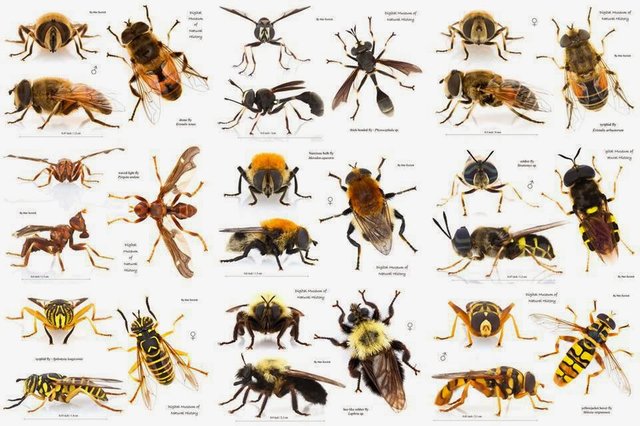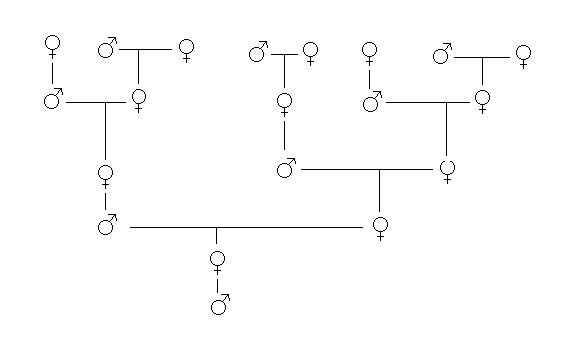Hello Steemit!
Its delicious and nutritious honey ... Its great job in the preservation of the environment as pollinators ... And its sting, although painful, it does it for the good of the hive. They are heroines! How not to love these beautiful insects?

The bees belong to the family of hymenoptera, from where the wasps and ants come. Its habitat encompasses everyone, except the places where the winter is very cold. There are several species of bees, but the one that is better known as honey bee is Apis mellifica or Apis mellifera.
Now, I will show you some data about bees that you might not know.
1. How are the hive cells constructed and why are they hexagonal in shape?
The worker bees are the ones that build the cells, they do it thanks to the wax secreted by their cherry glands, whose material is the most optimal for storing liquids (compared to the cellulose or mud that wasps use). The bees construct the cells in the form of hexagons, since it is the best way to group them, taking advantage of all the possible space.
The cells of the western worker bees have a width of 5.4 millimeters, however the width of the cells of the Asian bees is 4.9 millimeters. This is because the human being after the eighteenth century, increased the size of Western bees in order to increase their ability to transport more nectar and pollen. However, in the twentieth century it was proved that this manipulation turned out to be a big mistake, since the larger size of the bees brought as a consequence a greater resistance in flight, less speed and greater energy expenditure.
It should be noted that the queen bee is raised in vertical cells and larger than the other cells, which are horizontal.
2. An organization like no other
There are numerous species, among them there are solitary bees, others live in holes in the ground, some do not have a sting. The honey bee creates colonies of between 15,000 and 80,000 bees, depending on their strength, climate and environment. The beehives constitute the superorganism that forms three types of specimens: The female queen (one), the worker females (they form the majority in the hive) and male drones (less than 4% of the hive or none, depending on the time of year ).
The young queen can "swarm" the hive, that is, divide the hive her young queen can "swarm", divide the hive where part of the bees and the queen leave, which is replaced by a new one.
3. Types of bees inside the hive: There are two types of bees, females and males.
The male bees or drones:
They are haploid, that is, they are born from an unfertilized ovule, and therefore, they only have half of their mother's chromosomes, a female bee. They are characterized because their eyes are bigger than those of the females, they have a short tongue and therefore they have to be fed by the workers.
They lack odoriferous glands so they can enter any hive. Its main function is to fecundate the queen bee in the nuptial flight, where between 8 to 12 drones are needed to fertilize. Stronger males will fecundate the queen by reaching it more easily in its vertical flight, and the queen bee will store the males' sperm in an organ called spermatheca. After the copulation, the drone dies because his genital tract of the drone falls off. In case they fail to fertilize the queen, they will wander among the hives. In shortage of food, the worker bees expel the drones from the hive and die of hunger or cold.

The female bees:
They are diploid, that is, they are born from an egg and a sperm. At the beginning, all the females are equal and after three days, the workers will feed the chosen larvae to be queens with royal jelly which will develop from the reproductive organs to a greater extent. While the other larvae will be fed with honey, pollen, nectar and a little jelly. The queen bee is larger, with a long abdomen and short wings. In the hive only a queen can live and the first one to be born will kill the other queens that are placed. The young queen may respect the queen queen bee when the workers plan to replace an old queen or prepare a swarm.
In the following image, you can see the differences between the queen bee and worker bees.

The worker bees are infertile females, they are the smallest of the hive, their buccal apparatus is widely developed to obtain the nectar and then transform it into honey and have a kind of hair brush where they collect the pollen that then passes to the "basket" which is a change of the hind legs that allow the transport of pollen.
After 21 days, they enter their pecoreadoras stage, where their wax segregation glands atrophy and go out of the hive to collect nectar, pollen, propolis and water. The workers clean the hive, build the cells with the wax that you secrete, store the food in the combs, dehydrate the nectar by means of its generation of air currents and manufacture the royal jelly by means of its galactonogenic glands. In addition, they prevent the entry of bees that are foreign to their hive due to the Nassanoff gland, which generates a characteristic odor in the hive.
4. Bees Lifetime
Queen bees have an average life of 3 years, but can live up to 6 years, although their ability to reproduce reduces as they get older. The workers and the drones live around three months.
5. The choice of queen bees
The worker bees select larvae less than three days old, in case they need to replace a non-productive queen, swarm the hive to expand it or when the queen dies due to disease or attack by predators (such as like the bee-eater).
6. What is royal jelly?
Royal jelly is a substance produced by the hypopharyngeal glands of workers from 5 to 15 days of age, by means of pollen, nectar, water and enzymes until it has a creamy, whitish, highly nitrogenous consistency and bitter-acid taste. It is the food of all larvae (females or males) during the first three days of development and throughout the life of a queen. It consists of water, sugars, proteins, lipids, ash, vitamins, folic acid, antibiotics, albumins, amino acids and minerals. Stimulates the nervous and immune system, and increases cerebral oxygenation, resistance, the content of hemoglobin and leukocytes in the blood.

7. How is honey made?
Honey is a sweet and viscous fluid produced by bees from the collection of nectar of flowers or secretions of living parts of the plant. Their process is that these animals go from plant to plant collecting their secretions that are then mixed with their saliva that contains an enzyme called invertase (read well, saliva) in the combs where it matures.
Honey is a supersaturated substance of sugars and tends to a state of pasty or crystallized equilibrium. In the first months, the natural honey is liquid, until the hidroximetilfurfural (HMF) is forming crystals of fructose and glucose. While industrial honey is pasteurized, where the properties of natural honey are lost, HMF is broken and crystallization is inhibited.
8. What type of flowers do bees use?
In general, the flowers that feed bees have nectar, pollen, or both. The nectar is composed mostly of fructose, which will serve as an ingredient for honey. The bees also collect "mielatos" or forest honey, which are sugary substances secreted by sucking insects of pine and spruce sap.

Bees must travel long kilometers to get all the extracts. So they are not always the same types of plants or flowers and there are different flavors and colors of honey, from menthol, wood and other less sweet. The bees always work with a specific flower until it is exhausted in the middle, which differentiates them from other pollinators.
9. Do all bees sting? What happens after a bee stings?
The only bees that itch are the workers, which inject 50% of the poison at the time of stinging, while the rest of the poison will flow through it. In most cases, the bee can not recover the sting, which tears part of its abdomen and dies within minutes.
It is recommended to remove the sting by scraping it, because if done with your fingers, you can squeeze the poison bag (apitoxin) that is at the end of the sting and you can introduce the rest of the poison.
On the other hand, throughout history, the poison has been used to treat arthritis, osteoarthritis, tumors, Parkinson's or Alzheimer's.
10. "The Dance of the Bees"
The communication between these insects is very complex. They use the senses to interact, such as the sound that indicates a warning or location signal and the taste that communicates about the diversity of food to drink. In addition, by means of the pheromones that segregate, the tasks in the hive are regulated and harmonized.
The most important and striking interaction is "the dance of the bees", where the worker bees let others know they have found food, the direction with relative position to the sun and the distance from the hive.
11. How much raw material do bees need to make their honey?
It is important that the hive be strong against the factors of the climate and the time of flowering. However, in general terms, to collect 1 kilogram of honey, 2540 bees are needed flying 156 kilometers each, in order that each bee extracts the nectar of 3900 flowers.
12. The enemy of the bees
There is a parasitic mite called Varroa, which weakens the bees, causing an incomplete development. The varroa female makes the placement inside the cells of the larvae, and due to the suction of the mite's hemolymph, generates weakening of the bee: They are smaller, lack wings and die soon after.

On the other hand, the pesticides used for agriculture, disorients the bees and prevents them from returning to the hive.
13. Not all bees make honey
Out of more than 20,000 species of bees, only four can make honey. In the west, the best-known example is the Apis Mellifera; while, in the Asian continent, the most common are Apis Cerana, Apis Florea and Apis Dorsata.

14. A Stop Signal
This signal that sounds like a soft " uh, uh " can not be perceived by the human being; however, it can be detected by introducing an accelerometer into the honeycomb. Studies have concluded that bees emit this sound, not only to stop in their labors and stay alert, but also when something surprises them, like colliding with another bee.
15. Bees and Fibonacci
The family tree of a drone follows the Fibonacci series (1, 1, 2, 3, 5, 8, 13, 21, ...) This is because the drones only have a mother, and the females (worker or queen) have mother and father. So when counting the number of individuals and a generation, the Fibonacci succession is once again present in nature.

Other Sources:
https://ecocolmena.com/curiosidades_abejas/
https://www.taringa.net/posts/ecologia/9571047/20-Datos-curiosos-sobre-las-abejas.html
http://www.culturizate.com/6-curiosidades-que-no-sabias-sobre-abejas-miel/
https://es.gizmodo.com/escucha-el-extrano-sonido-que-emiten-las-abejas-cuando-1792361742
http://unfibonaccideoro.ieselcarmen-cazalla.es/zangano.html
Thank you for Reading!